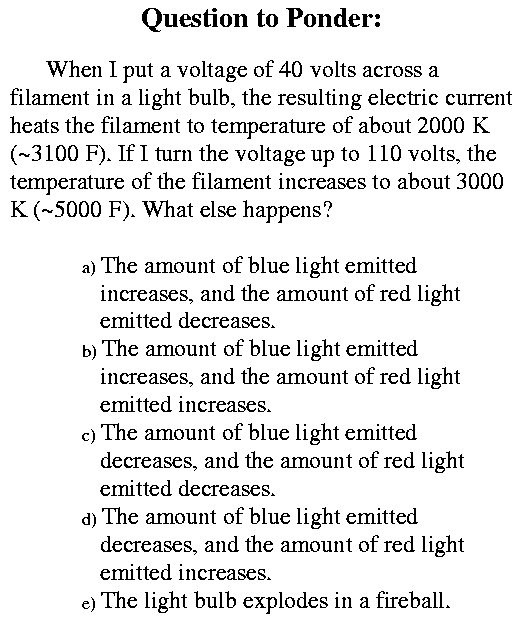|
|
We're having a heat wave A tropical heat wave The temperature's rising It isn't surprising She certainly can can-can Irving Berlin, Heat Wave |
Assignments:Problem Set #1 due Thursday 5pmNote-- Two errors from class are corrected in the notes below:
|

In Class:
ponderous question
- first watch what happens
- lookit only the red part
- now lookit only the blue part
- let's lookit a plot of what we just watched
2000 K
- pretty wimpy
- not much emission at any wavelength
--> a dim bulb
3000 K
- much brighter at ALL wavelengths (e.g., red and blue)
- curve is higher everywhere
--> brighter bulb
for a single object, HOTTER MEANS BRIGHTER
at all wavelengths
- Now, for a given increase in T,
the brightness change isn't the same at all wavelengths
in our example, the blue light increases by a lot more
than the red light (though both _do_ increase)
we can see this in how the curve moves upward
_and_ to the left.
This is consistent with our idea that as we turn up the temperature,
we can generate more short wavelength (i.e., high energy) photons.
- the "peak" of the blackbody spectrum moves to the right as T increases,
is the same as saying
lambda_peak = 0.003/T (Wien's Law)
This is neat. Why?
- now we can tell how hot something is by what color light it emits
ex.: the Sun
the Solar spectrum peaks at a wavelength of 518 nm
(middle of the visible spectrum; yellowish)
what is its T?
lambda = 0.003/T
518e-9 = 0.003/T
T = 0.003/518e-9
= 5800 K
--> we just took the temperature of the surface of the Sun
without leaving our seats
speaking of taking temperatures, how about us?
our temp is 98.6 F = 37 C = 310 K
What is the peak wavelength of our emission?
Yes, we emit, just like everything else with
temperuature > 0 K
lambda = 0.003/310 = 9.7e-6 == 9700 nm
infrared
REAL WORLD APPLICATION: ear thermometers
- measure the light coming from your ear
calculate the wavelength of peak emission
--> get T
MORE SINISTER REAL-WORLD APPLICATION:
- infrared imagers for finding people hiding the in forest
(e.g., military applications)
anyone see PREDATOR?)
or airplane exhaust in the sky (BROKEN ARROW)
or subs in the ocean (HUNT FOR RED OCTOBER)
-----------------------------
The T also tells us how much light in total is emitted
not just the favorite wavelength, but also the total energy
put out at all wavelengths
-- should make sense, since T is a measure of the
amount of energy available.
Another important aspect of the Planck function for thermal emission:
higher T produces a lot more brightness
not only to the curves shift to the left as T increases,
they also get MUCH bigger
The total amount of energy emitted by an object of temperature T
over all wavelengths (i.e., the integrated intensity)
-- varies not just as the T
(which you might expect, since T is a measure of
the energy available)
-- but instead as T^4
-- the reasons for this are pretty complicated
but you can think of it as coming from the
fact that really hot objects cool off
faster than only moderately hot objects
the energy per second (which is the intensity)
lost due to radiation (or making photons)
is much higher for hotter objects
Stephan-Boltzmann law = I = sigma T^4
sigma = 5.67e-8 W/m^2 / K^4
ex.: your intensity: T = 300 K
I = 5.67e-8 300^4 = 459 W/m^2
ex.: the Sun's intensity: T = 6000 K
I = 5.67e-8 6000^4 = 7.35e7 W/m^2
73 million W/m^2
the higher intensity of the Sun, coupled with the fact
that the Sun has a lot more emitting area
is why the Sun emits a lot more light than you do.
We'll see that this result is pretty important for determining the
Luminosities of stars
--------
OK, now let's look at stars
BB law works pretty well to explain the spectra of stars
-- spectra of three real stars
-- brightness as a function of wavelength (4000-7000 ang)
-- e.g. put a camera where your head is
-- measure brightness as a function of wavelength
-- make a plot
-- what color would the first star be?
-- most of the light comes out in the blue
actually doesn't look like a BB fn; but just wait
-- what about the bottom star's color?
-- most of the light comes out around 500 nm
more yellowy; like our Sun
Planck functions can fit pretty well all three stars
-- bottom one looks like a Planck function
and T=5800 K fits pretty well
-- middle one has a peak at slightly shorter wavelegnth
-- we'll need a higher T; T = 7500 is pretty good
-- hottest one looks goofy; why?
-- most of the light comes out at even shorter wavelegnths
-- we're only seeing part of the spectrum in the optical
-- a really hot (30000 K) Planck function fits pretty well
So, we can take the temperatures of stars pretty easily using the
information from the Planck fn.
-- find the Planck fn which "fits" the observed spectrum best.
-- we discover that stars have T's like 3000 K to 30000K
and sometimes a little higher
-- this tells us a little about what they're made of
(ie., probably not ice)
-- however, since the BB fn is independent of composition
(recall table, chair, and you all emit a spectrum according to
your temp)
we can't really tell exactly what the stars are
made of from this information
|
![]()